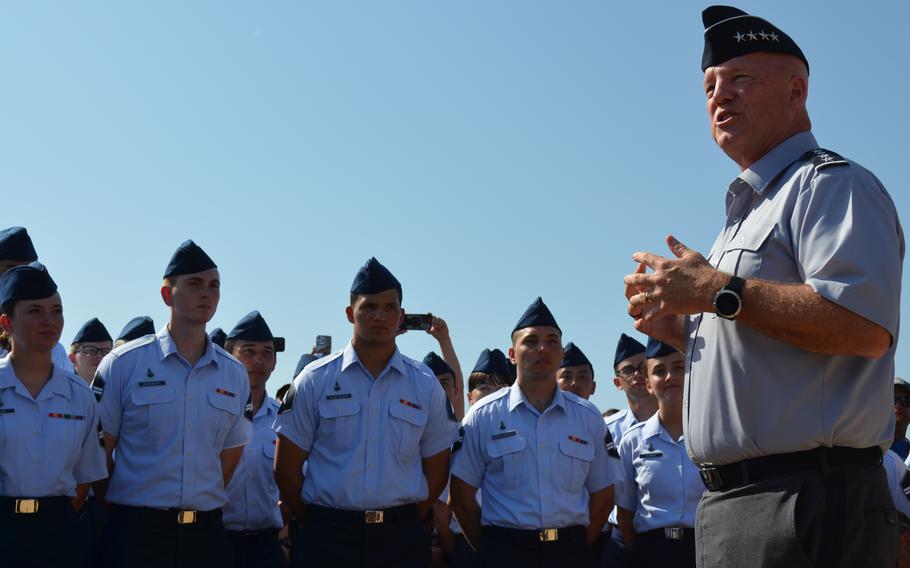
Gen. John Raymond, chief of space operations, addresses the 71 new guardians to graduate basic training Thursday, June 23, 2022, and enter the Space Force. The trainees were the first to participate in a unique, space-centric curriculum in conjunction with Air Force basic training at Joint Base San Antonio-Lackland Air Force Base in Texas. (Rose L. Thayer/Stars and Stripes)
SAN ANTONIO, Texas — The Space Force’s 71 newest guardians marched in two flights across a heat-scorched parade field Thursday morning, bringing yet another first to the youngest branch of the military — the first boot camp graduates to train under a unique, Space Force-centric curriculum.
The guardians stood among more than 700 new airmen. While they all wore the same dress blue uniforms, the guardians were distinguished by the Space Force patches on their sleeves, and the new flags that designated their training flights.
After raising their right hands for oath of enlistment, the new guardians increased Space Force’s total number of active-duty service members to 7,227, said Gen. John Raymond, chief of space operations. Space Force aims to have 8,400 guardians by the end of the year.
“It's critical to the service that you build your own people, and you develop your force. Every domain is unique, whether it's the ground domain, air domain, sea domain or the space domain,” Raymond said. “Having an opportunity to grow these young guardians from day one with the core values and with the skill sets needed to be successful in this domain called space is really important to the service.”
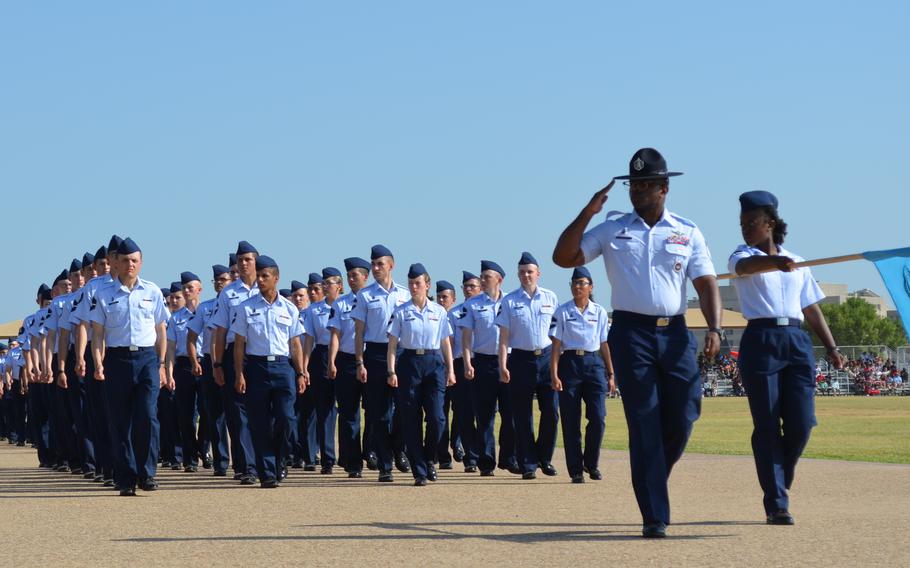
Space Force guardians march Thursday, June 23, 2022, during basic training graduation at Joint Base San Antonio-Lackland Air Force Base in Texas. (Rose L. Thayer/Stars and Stripes )
The first enlisted guardians began arriving at Lackland Air Force Base for basic training in October 2021, with seven graduating at the end of that year. Those early troops attended the same 7.5-week training as Air Force recruits.
Since then, about 800 guardians have entered Space Force through basic training, said Chief Master Sergeant of the Space Force Roger Towberman, who attended Thursday’s ceremony along with Raymond. Other troops came to the service by transitioning from other service branches.
Moving forward, Lackland will receive a new class of guardians every eight weeks, but Towberman said it’ll take about a year to determine whether roughly 70 students every rotation is the right amount for the service.
“What we do at basic training impacts what happens in recruiting, and it impacts what happens in tech schools and it impacts what we call absorption rate into the operational force,” he said. “We’ve been playing with different models, and we’ll keep playing with different models.”
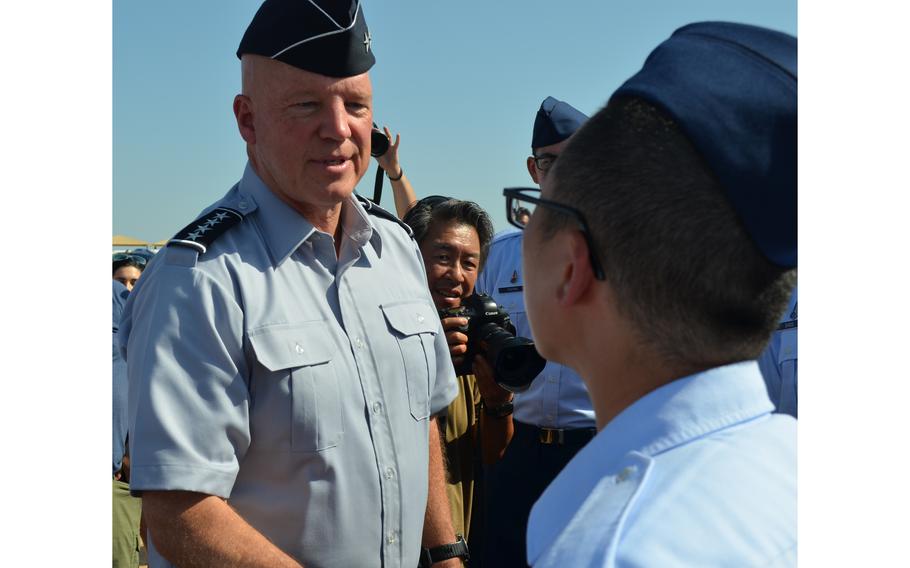
Gen. John Raymond, chief of space operations, congratulates the 71 new guardians to graduate basic training Thursday, June 23, 2022, and enter the Space Force. The trainees were the first to participate in a unique, space-centric curriculum in conjunction with Air Force basic training at Joint Base San Antonio-Lackland Air Force Base in Texas. (Rose L. Thayer/Stars and Stripes )
Like the recruits to graduate Thursday, future Space Force trainees will live in a Space Force-only dorm and participate in about 35 hours of space-specific curriculum taught by guardians. For the rest of their training, they will merge with Air Force trainees.
The new curriculum is centered on the Space Force’s four core values — commitment, courage, character and connection, said Col. Jeffrey Pixley, commander of the Air Force’s 737th Training Group, which oversees basic training for the Air Force and Space Force.
The instructors leading the training are former airmen who switched to the Space Force, he said.
“One day we’ll have Space Force [military training instructors] who went through Space Force [basic military training],” he said. “What we're doing right now is purposely and unintentionally infusing the Air Force culture into the Space Force. Because as their parent service, they grew out from that connection. I think is important and it's always going to be there.”
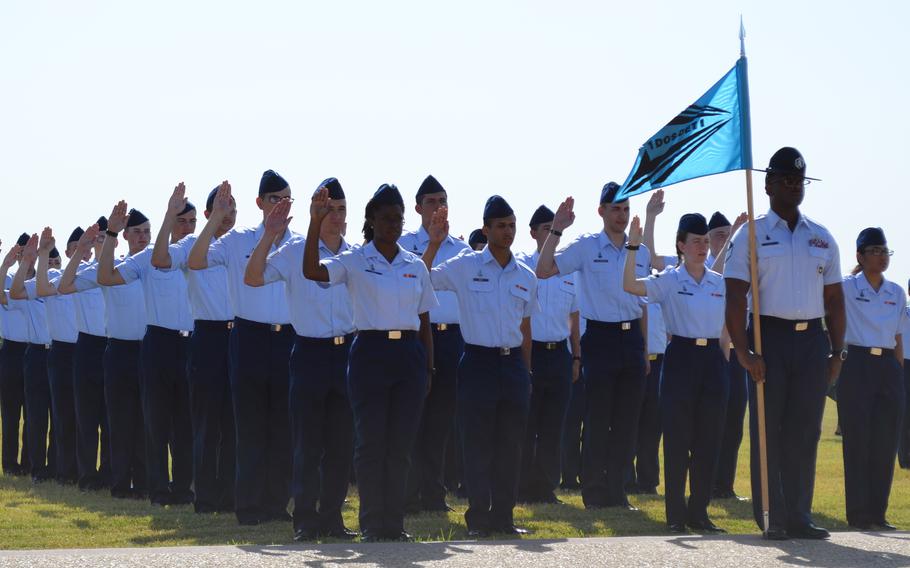
Space Force guardians recite the oath of enlistment Thursday, June 23, 2022, during basic training graduation at Joint Base San Antonio-Lackland Air Force Base in Texas. (Rose L. Thayer/Stars and Stripes )
Master Sgt. Phillip Lowery, a former Air Force basic training instructor who moved to the Space Force, helped shape the curriculum now used for the service’s basic training. Once the working group identified what they saw as missing from the Air Force curriculum, they focused on how to get the information to guardians. That included a class on guardian values and an entry level class into space and cyber, both meant to help new troops once they get to their next phase of training.
“If we can give them a different perspective on space operations, when they get to their technical training, maybe their learning curve is a little less,” said Lowery, who now serves as the senior enlisted leader for the 1st Delta Operations Squadron at Vandenberg Space Force Base, Calif.
Space Force has only five distinct career fields: operations, acquisition, engineering, intelligence and cyber. After graduation from basic, the 71 new guardians will move on to their technical training, which is focused on the career field they chose. It’s taught at Vandenberg Space Force Base, Keesler Air Force Base, Miss., and Goodfellow Air Force Base, Texas, Raymond said.
While recruits coming in are excited for the mission — Space Force remains highly selective, with a board choosing who makes the cut — Raymond said the service is still challenged with helping the American people understand the Space Force mission.
“It's really hard to have a connection with something that's orbiting overhead,” he said.
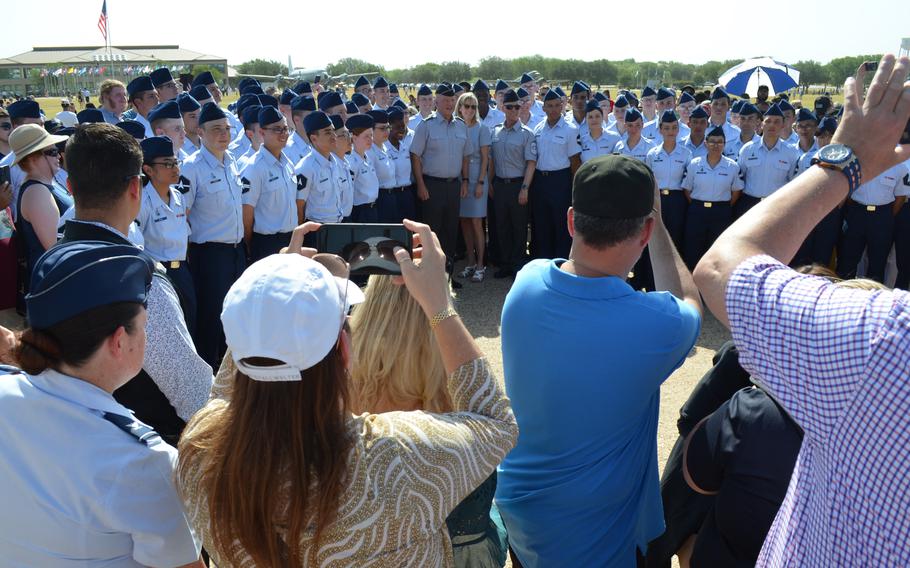
Gen. John Raymond, chief of space operations, and his wife Mollie Raymond pose with Space Force basic training graduates Thursday, June 23, 2022, at Joint Base San Antonio-Lackland Air Force Base in Texas. (Rose L. Thayer/Stars and Stripes )
However, space is responsible for making a smart phone operate, delivering weather reports, providing directions through GPS and allowing people to pay for gas at the pump instead of walking inside, Raymond said.
“The way you understand space is if it ever went out and you lose those capabilities. Our goal is to make sure that that never happens,” he said.
As the Space Force continues to hit new milestones in its path toward full operations, Towberman and Raymond said they are in no hurry to separate from the Air Force when it comes to basic training. Instead, they are focused on keeping the force small, agile and able to adapt to the rapidly changing technology related to space operations.
“We’re new and we can do things differently,” Raymond said. “We've purposely built ourselves to be small so we can be fast.”